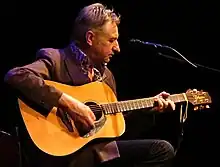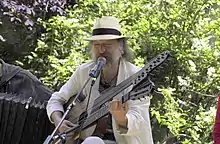Neue Volksmusik
Neue Volksmusik (sometimes also called Volxmusik or Tradimix; English for "New folk music") describes the crossover mix of traditional German folk music (Volksmusik) with newer genres such as jazz, contemporary folk, electronic music, and/or rock.[1][2]

Hubert von Goisern

Georg Ringsgwandl (2011)

Roland Neuwirth
| Neue Volksmusik | |
|---|---|
| Etymology | German for "New Folk Music" |
| Other names | Volxmusik, Tradimix |
| Stylistic origins | |
| Cultural origins | 1970's Germany |
| Typical instruments | |
| Derivative forms | Dansband |
| Regional scenes | |
| Central Europe, Northern Europe, Southeastern Europe | |
| Other topics | |
| Music of Germany | |
References
- Nestler, Lucas (18 May 2014). "Neue Volksmusik". Music News (in German). Retrieved 22 September 2018.
- "Neue Volksmusik". SRF Swiss Radio (in German). 9 September 2015. Retrieved 22 September 2018.
This article is issued from Wikipedia. The text is licensed under Creative Commons - Attribution - Sharealike. Additional terms may apply for the media files.